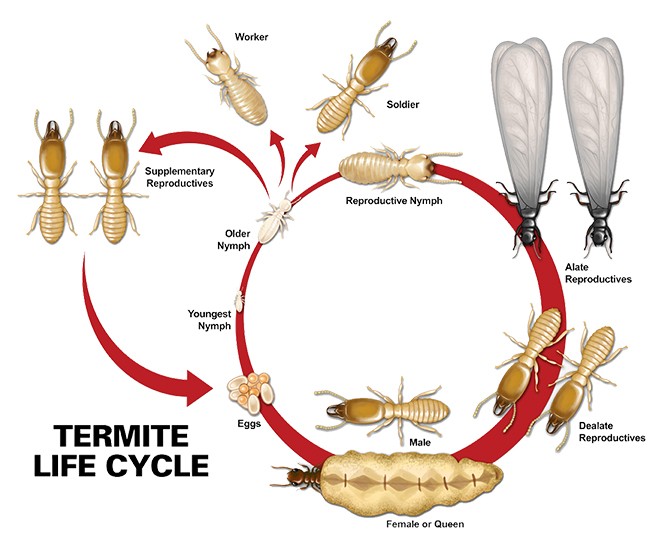


Subterranean termites are common throughout Malaysia and can be found infesting fallen trees, stumps, or other dead wood in contact with the soil in the forest, landscape, or structural lumber in our houses. The species of economic importance are within the genera Reticulitermes, Heterotermes, and Coptotermes. Other genera of subterranean termites found in Malaysia are mostly restricted to the desert areas in the southeastern corner of the state and are generally not important pests.
The most common subterranean termites, Reticulitermes, can be encountered in nearly all regions of the state, from the sand dunes of the coast to the upper elevations of the mountain ranges and even in some of the desert areas. The species of Reticulitermes are the most destructive termites found in Malaysia. They are small in size compared to damp wood and dry wood termites, but mature colonies can contain hundreds of thousands of individuals.
Reproductive winged forms of subterranean termites are dark brown to brownish-black with brownish-gray wings. On warm, sunny days following fall or spring rains, swarms of reproductives may be seen emerging en masse from their underground nests. Soldiers are wingless with light caramel-colored bodies and long, narrow amber-colored heads with no eyes. Workers are slightly smaller than reproductives, wingless, and have a shorter head than soldiers; their color is similar to that of soldiers.
In Malaysia, Heterotermes aureus is the most destructive species of subterranean termites. This species has light-brown winged forms that fly in the early evening and are attracted to lights. Another destructive species in this group, the Formosan subterranean termite, Coptotermes formosanus, is native to China but now established in Malaysia, thus far restricted to a small area. Unlike the native Reticulitermes but similar to Heterotermes, Formosan subterranean termites swarm at dusk and are attracted to lights.
Termite colonies are self-perpetuating. When the colony, composed of a large number of individuals, often in thousands, a small percentage of individuals would develop into winged reproductives (alates or swarmers) and then leave the nest, flying in swarms to mate, disperse, and set up new colonies. Most of these reproductive perish during the flight due to predation by birds, lizards, ants, or other insects. The time of day and year when flights occur varies with species and geographic location. Reticulitermes species swarms during the afternoon in either spring or fall on clear days after a soaking rain. Heterotherms aureus flies in the late afternoon or early evening in July, August, and September. Coptotermes formosanus, although rare in California, flies in the late evening and is attracted to lights. In buildings with heated basements, termites occasionally fly inside during winter.
New kings and queens are winged during their early adult life and generally fly less than 100 meters from their colony. Once they land on the ground they find a mate and begin the search for a nest site. A colony begins when a mated pair constructs a small underground chamber, which they enter and seal. Soon afterward mating occurs and the female begins laying eggs.
Most species of termites have microscopic one-celled organisms, called protists, within their intestines that help in converting otherwise indigestible cellulose from wood into food for the colony. Both the king and queen feed the young on predigested food, thereby transferring these intestinal protists until the new brood is able to feed themselves. Once workers are produced, the king and queen are fed by them and stop feeding on wood.
Surprisingly, termites are long-lived; queens and kings can have a lifespan of a decade or more, while each worker can live for one to several years.

SIGNS OF SUBTERRANEAN TERMITE INFESTATION
Signs of a subterranean termite infestation include swarms of winged reproductive in the spring, summer, or fall, the presence of shelter tubes, and evidence of tunneling in wood. Shelter tubes (sometimes called mud tubes) are the most commonly seen evidence of a subterranean termite infestation. These earth-hardened tubes are made by workers using saliva mixed with soil and bits of wood or even drywall. There are four types of tubes:
working tubes are constructed from the nest in the soil to wooden structures and they may travel up concrete or stone foundations;
exploratory and migratory tubes arise from the soil but do not connect to wood structures;
drop tubes extend from wooden structures back to the soil; and
swarm tubes for new and swarming reproductive kings and queens to emerge from and fly away during swarm season.
If you break termite tubes open, you may see live workers and soldiers running through the tubes. The darkening or blistering of structural wood members is another possible indication of an infestation; wood in damaged areas is typically thin at the surface and easily punctured with a knife or screwdriver. Finding live termites foraging within wood is a sure sign of an active infestation.
The excavations that termites make in wood are hollow, completely enclosed, more or less longitudinal cavities. Some species deposit light-brown excrement within cavities. Feeding in wood by subterranean termites generally follows the grain of the wood; these species attack the softer springwood and leave the harder, less digestible summerwood. Many times, this distinctive pattern of wood damage alone can be used to positively distinguish subterranean termite activity from that of other species.

ECOLOGICAL AND BEHAVIORAL CHARACTERISTICS OF SUBTERRANEAN TERMITES
The ecology and behavior of subterranean termites offer useful information for homeowners and the pest control industry, providing new insights into the management of these potential pests.
Subterranean termites require moist environments. To satisfy this need, they usually nest in or near the soil and maintain some connection with the soil through tunnels in wood or through shelter tubes. Furthermore, because of the moisture requirements of subterranean termites, they are often found in wood that has been slightly decayed. Soil serves as a source of moisture that protects termites from desiccation, shields them from predators, and can be used as a building material for shelter tubes and carton nests (Formosan subterranean termites) above ground. Termites can also excavate passageways through the soil to reach additional food sources.
Reproduction and Dispersal
New subterranean termite colonies are typically started from an initial male and female pair (incipient colony). Pair formation occurs after the reproductive nuptial flight. Mated pairs usually begin laying eggs immediately. At the end of a year, a colony may have grown to only 75 individuals. Very few of the reproductive that flies each year ever pair up and establish a new colony; and very few of the colonies established ever reach maturity. Colonies that survive to maturity can contain hundreds of thousands of individuals and pose a serious threat to structures.
Subterranean termite colonies may also be established by the division of an existing colony. Colonies send workers to look for new food sources. If a new supply is found, then more individuals are recruited to the site. After a while, a subcolony is established with a continuous exchange of foragers between this group and the main portion of the colony. Then for any number of reasons, the subcolony may be cut off from the mother colony; and the exchange of individuals terminated. This subcolony has the capacity of producing its own reproductives and developing rapidly as an independent colony.
Most subterranean termite species consume wood at about the same rate, but three factors can make some species potentially more voracious and damaging than others. These factors include the environment in which they live (termites eat more wood when conditions are optimal over a longer period of time), the size of the insects (larger insects eat more wood), and the number of insects (larger colonies eat more wood).
One of the chief means of shared feeding is called trophallaxis or the mutual exchange of gut contents between colony members. Trophallaxis also permits the efficient use of nutrients, recognition of colony members, distribution of chemicals involved in caste regulation, and the transfer of cellulose-digesting protozoans. Many members of a termite colony cannot feed themselves, so they rely on other colony members to feed them. This behavior also facilitates the transfer of toxicants used in baits and other insecticides.
The nesting system of subterranean termites in Malaysia consists of a network of galleries that extend into the ground and can enlarge into more spacious chambers. The foraging territories of colonies of pest species can comprise a single foraging site or many sites around a single building, and the size of the populations utilizing these territories can range from a few tens of thousands to hundreds of thousands of individuals. A home with a footprint of 2400 square feet could have several termite colonies with hundreds of thousands of foragers seeking food and shelter.





